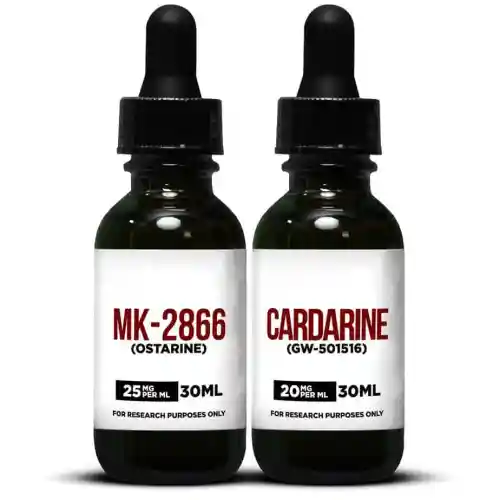Protocol for Researching the Super Endurance Bundle:
Ostarine – For research use only, 1 filled oral syringe daily. Ostarine can be researched for up to 8 weeks.
Cardarine – For research use only, 1 filled oral syringe daily. Research can be done for up to 12 weeks. A 6-week break is needed after 12 weeks of research, before beginning research again.
PCT – After completion of the cycle, Clomid should be used as PCT, at 1 syringe per day for 30 days.
Cardarine
GW501516 was initially discovered during a research collaboration between GSK and Ligand Pharmaceuticals that began in 1992. The discovery of the compound was published in a 2001 issue of PNAS. Oliver et al. reported that they used “combinatorial chemistry and structure-based drug design” to develop it. One of the authors was the son of Leo Sternbach who discovered benzodiazepines in the 1960s.
R & D Focus Drug News reported that GSK began phase I trials of the compound for the treatment of hyperlipidemia in 2000 followed by phase I/II in 2002. In 2003, Ligand Pharmaceuticals earned a $1 million payment as a result of GSK continuing phase I development.
By 2007, GW501516 had completed two phase II clinical studies and other studies relating to obesity, diabetes, dyslipidemia and cardiovascular disease, but GSK abandoned further development of the drug in 2007 for reasons which were not disclosed at the time. It later emerged that the drug was discontinued because animal testing showed that the drug caused cancer to develop rapidly in several organs, at dosages of 3 mg/kg/day in both mice and rats.
Ronald M. Evans’s laboratory purchased a sample of GW501516 and gave mice a much higher dose than had been used in GSK’s experiments; they found that the compound dramatically increased the physical performance of the mice. The work was published in 2007 in Cell and was widely reported in the popular press including The New York Times and The Wall Street Journal.
Ostarine
GTx Incorporated was founded in Memphis in 1997 and licensed rights to enobosarm from the University of Tennessee Research Foundation; the SARM compounds were invented by James T. Dalton, Duane D. Miller, Karen A. Veverka and their research teams at Ohio State University, the University of Tennessee and GTx, respectively.
By 2007, enobosarm was in a Phase II trial, and that year GTx signed an exclusive license agreement for its SARM program with Merck & Co. The companies ended the deal in 2010.
In August 2011, there was a double-blind, placebo controlled phase II trial that focused on elderly men and postmenopausal women which concluded that Enobosarm showed statistically significant improvements in total lean body mass and physical function without the negative side effects that are normally present with steroids

